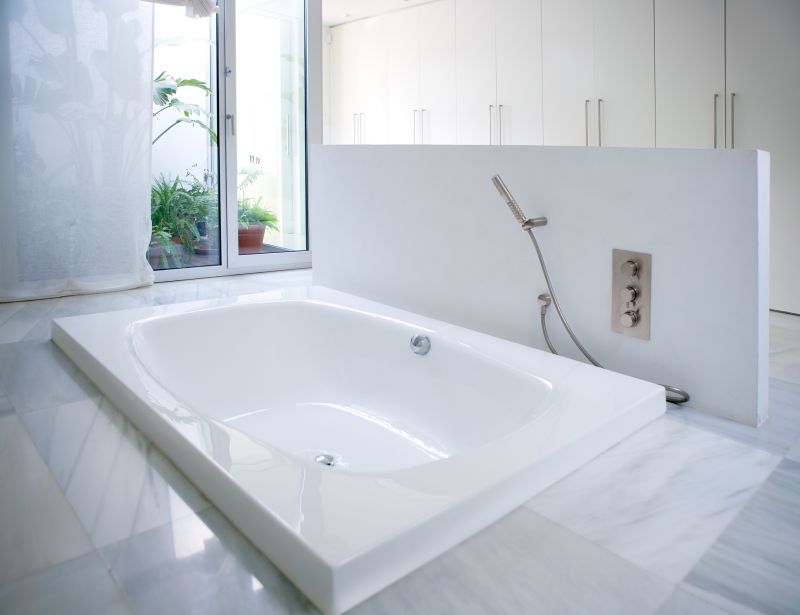Favorite Products For Bathtub Refinishings To Enhance Your Bathroom
Learn about the most popular products that make bathtub refinishing straightforward, effective, and lasting.
 Bathtub refinishing is a practical solution for revitalizing worn or outdated tubs, offering a fresh appearance without the need for complete replacement. The process typically involves applying specialized coatings or paints that adhere to the existing surface, providing a smooth, durable finish. This approach can significantly enhance the aesthetic appeal of a bathroom while potentially extending the lifespan of the bathtub. It is important to select the right products to ensure a long-lasting and professional-looking result.
Bathtub refinishing is a practical solution for revitalizing worn or outdated tubs, offering a fresh appearance without the need for complete replacement. The process typically involves applying specialized coatings or paints that adhere to the existing surface, providing a smooth, durable finish. This approach can significantly enhance the aesthetic appeal of a bathroom while potentially extending the lifespan of the bathtub. It is important to select the right products to ensure a long-lasting and professional-looking result.
Top Overall Option
Epoxy Coating Kit
An epoxy coating kit offers a durable, high-gloss finish suitable for various bathtub surfaces. It provides excellent adhesion and resistance to stains, scratches, and moisture, making it a popular choice for both DIY projects and professional refinishing. Proper surface preparation and application are essential to maximize its longevity and appearance.
Types of Products For Bathtub Refinishings
Acrylic Enamel Paints
Suitable for quick touch-ups and small refinishing projects, acrylic enamel paints are easy to apply and dry quickly, offering a smooth, glossy finish.
Epoxy Coatings
Known for their durability and strong adhesion, epoxy coatings are often used for complete bathtub refinishing, providing a long-lasting surface.
Polyurethane Sealers
These sealers enhance the durability of refinished surfaces and provide a glossy, protective layer against moisture and stains.
Refinishing Kits
All-in-one kits typically include primers, paints, and sealers, designed for DIY enthusiasts to refinish tubs with comprehensive instructions.
Spray-On Coatings
Ideal for smooth, even finishes, spray-on coatings require proper equipment and technique for optimal results.
Brush-On Resins
These resins are applied with brushes or rollers, suitable for detailed work or smaller refinishing areas.
Ceramic Coatings
Offering a hard, ceramic-like finish, these coatings are resistant to heat and scratches, suitable for high-use tubs.
UV Cured Finishes
These products cure quickly under ultraviolet light, providing a durable and glossy surface with minimal drying time.
Marine-Grade Paints
Designed for water-resistant environments, marine-grade paints can be used for refinishing tubs exposed to high moisture levels.
High-Temperature Resistant Coatings
These coatings withstand heat exposure, making them suitable for tubs with heating elements or steam features.
Textured Finishes
Adding texture to the surface can improve slip resistance and hide imperfections, available in various formulations.
Anti-Microbial Coatings
These coatings inhibit mold and mildew growth, contributing to a cleaner, healthier bathroom environment.
Popular Choices
Widely used for their durability and professional finish, epoxy kits are favored for comprehensive bathtub refinishing projects.
Popular for quick fixes and small projects, offering ease of use and good gloss.
Chosen for their smooth, even coverage, especially on large or complex surfaces.
Complete kits that simplify the process for DIYers, including all necessary components.
Commonly used to protect and enhance the durability of refinished surfaces.
Increasing in popularity due to their hard, scratch-resistant finish.
Gaining popularity for their quick curing times and glossy results.
Preferred for tubs with heating features or high heat exposure.
Chosen for slip resistance and aesthetic variation.
Popular for maintaining hygienic bathroom surfaces.
Refinishing products vary widely in formulation, application methods, and durability. Some kits are designed for DIY enthusiasts, offering user-friendly instructions and components that can be applied with simple tools. Others may require professional application to achieve optimal results, especially for complex or large surfaces. When choosing products, factors such as surface compatibility, drying time, and resistance to stains and scratches should be considered.
Proper preparation is key to successful bathtub refinishing. This includes cleaning the surface thoroughly, removing any existing coatings or caulking, and ensuring the area is well-ventilated during application. Many refinishing products include primers or bonding agents to improve adhesion. After application, curing time varies depending on the product, and it is advisable to avoid using the tub until the finish is fully set to prevent damage.
Investing in quality refinishing products can help achieve a professional-looking finish that lasts for years. Regular maintenance, such as gentle cleaning and avoiding abrasive tools, can help preserve the new surface. Whether tackling a minor touch-up or a complete overhaul, selecting appropriate products and following manufacturer instructions carefully is essential for a successful bathtub refinishing project.
Key Buying Considerations
- Compatibility with existing bathtub material (fiberglass, porcelain, acrylic, etc.)
- Ease of application and whether the product is suitable for DIY use
- Drying and curing times to plan your project timeline
- Resistance to stains, scratches, and moisture for long-term durability
- Finish type desired, such as glossy, matte, or textured
- Surface preparation requirements to ensure proper adhesion
- Coverage area per unit to estimate quantities needed
- Ventilation needs during application to ensure safety and proper curing
- Compatibility with existing fixtures and fittings
- Ease of cleaning and maintenance after refinishing
- Availability of primers or bonding agents for better adhesion
- Cost and value for money considering the quality and coverage
- Manufacturer instructions and recommended application techniques
- Presence of anti-microbial or protective features if desired
- Environmental conditions in your bathroom that may affect curing and durability
